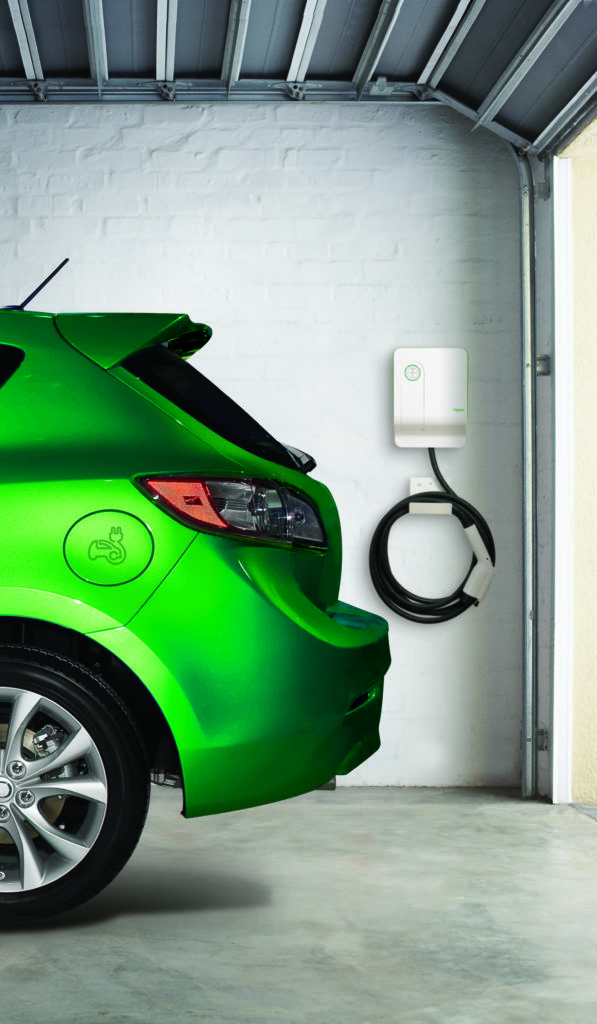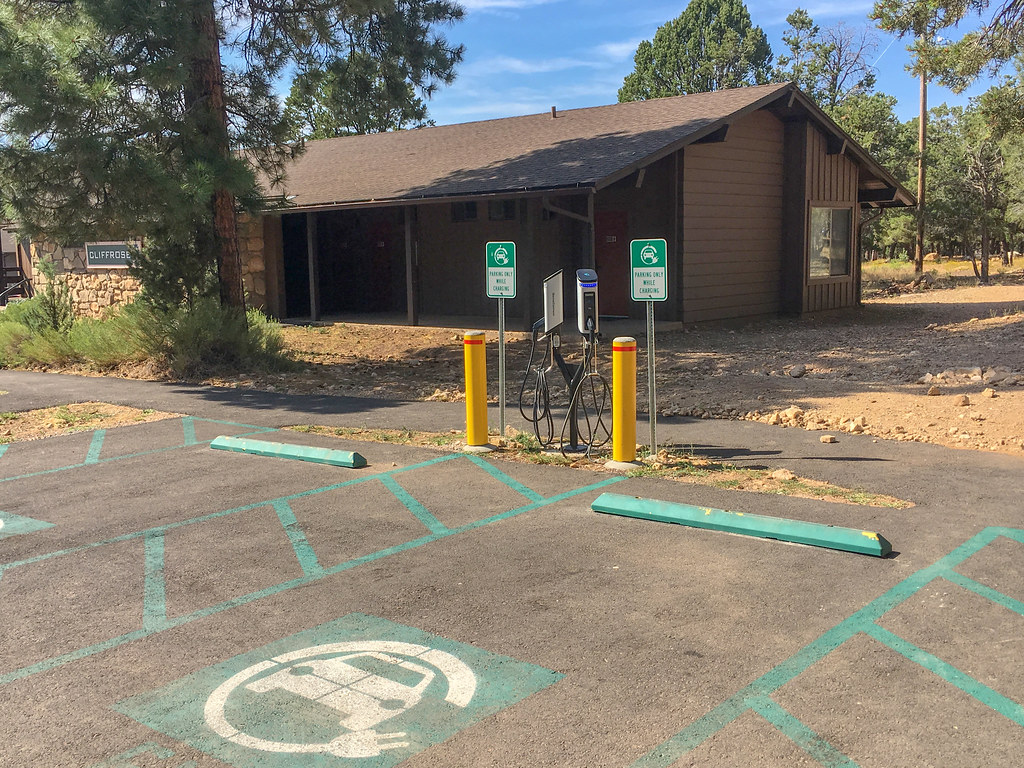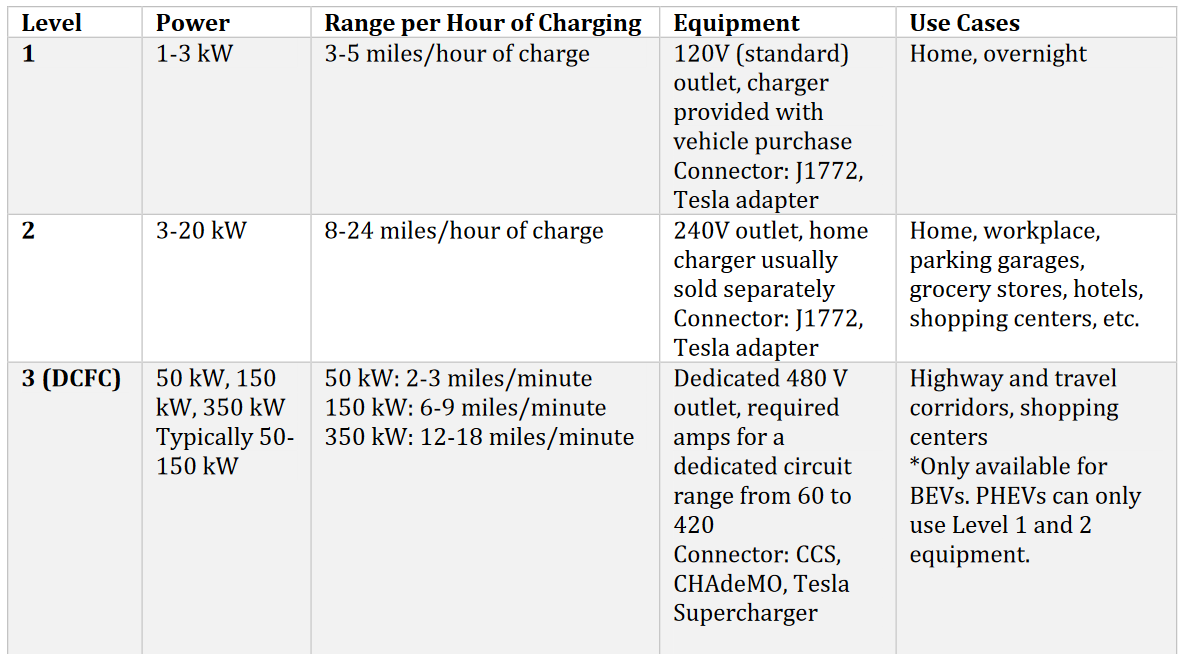01/12/21
Electric Vehicles Roadmap Initiative: A guide to passenger and commercial EVs
Oregon Gov. Kate Brown’s WGA Chair Initiative, the Electric Vehicles Roadmap, was launched in July 2020. The initiative is focused on the planning, siting and coordination of electric vehicle (EV) infrastructure in western states.
This “EV 101” guide is intended to promote understanding of passenger and commercial EVs by providing an overview of their various types, their typical driving ranges, how they are charged or fueled, and how western states are currently supporting EV infrastructure investments.
PASSENGER VEHICLE
Electric Vehicles
Battery Electric Vehicles
 Battery electric vehicles (BEVs), the most common type of plug-in EV, are powered exclusively by electricity stored in batteries. BEVs can be charged at home using a standard electrical outlet or at public charging stations using specialized equipment. A BEV’s range with a fully charged battery is dependent on the vehicle model, size of the battery, and the driver’s acceleration and braking habits. Due to advances in vehicle and battery technology, BEV ranges have increased significantly, with many recent models offering ranges close to 250 miles per full charge. Consumers can use www.fueleconomy.gov to research driving ranges for BEVs.
Battery electric vehicles (BEVs), the most common type of plug-in EV, are powered exclusively by electricity stored in batteries. BEVs can be charged at home using a standard electrical outlet or at public charging stations using specialized equipment. A BEV’s range with a fully charged battery is dependent on the vehicle model, size of the battery, and the driver’s acceleration and braking habits. Due to advances in vehicle and battery technology, BEV ranges have increased significantly, with many recent models offering ranges close to 250 miles per full charge. Consumers can use www.fueleconomy.gov to research driving ranges for BEVs.
Popular BEV models include the Tesla Model 3, Nissan Leaf, and Chevy Bolt.
Hybrid Electric Vehicles
Hybrid electric vehicles (HEVs) are powered by an internal combustion engine (ICE) in combination with one or more electric motors that use energy stored in batteries. Standard HEVs do not draw electricity from an external source. Instead, the batteries are charged via regenerative braking and the ICE. These batteries can reduce engine idling, help power the vehicle at low speeds and for short distances, and power auxiliary loads, all of which increase vehicle fuel economy. Most HEVs function as “parallel hybrids” by connecting the engine and electric motor to the wheels through mechanical coupling.
Many automobile manufacturers offer hybrid options for common ICE models, such as the Chevrolet Malibu, Ford Focus, and Honda Accord. Other HEV models, such as the Toyota Prius, are available only in a hybrid format.
Plug-In Hybrid Electric Vehicles
 Plug-in hybrid electric vehicles (PHEVs) use batteries to power an electric motor and gasoline or diesel to power an ICE. PHEV batteries can be charged using a standard wall outlet or specialized charging equipment, by the ICE, and through regenerative braking. PHEVs typically operate on electric power until the battery is nearly depleted, and then the vehicle automatically switches to using the ICE. Many PHEV models offer electric ranges of 15 to 60 miles, making them an attractive option for consumers who primarily drive short distances and are interested in EVs.
Plug-in hybrid electric vehicles (PHEVs) use batteries to power an electric motor and gasoline or diesel to power an ICE. PHEV batteries can be charged using a standard wall outlet or specialized charging equipment, by the ICE, and through regenerative braking. PHEVs typically operate on electric power until the battery is nearly depleted, and then the vehicle automatically switches to using the ICE. Many PHEV models offer electric ranges of 15 to 60 miles, making them an attractive option for consumers who primarily drive short distances and are interested in EVs.
Common models that include a PHEV option include the Ford Fusion, Toyota Prius, and Volvo S90.
Hydrogen Fuel Cell Electric Vehicles
Hydrogen fuel cell electric vehicles (FCEVs) represent an emerging technology powered by the electrolysis of hydrogen fuel. FCEVs are equipped with a proton exchange membrane fuel cell stack that separates hydrogen molecules into protons and electrons; the electrons subsequently provide power to the motor. FCEVs do not produce the emissions (other than water vapor) that ICE vehicles do.
FCEVs are filled at hydrogen fueling stations, most of which in the U.S. have been added to existing gas stations. The process of fueling an FCEV, similar to filling an ICE vehicle with gasoline, takes approximately five minutes. Currently, the vast majority of publicly available hydrogen fueling stations are located in California, but efforts are underway to expand the hydrogen fueling station network. A map of hydrogen fueling stations can be accessed here.
The California Fuel Cell Partnership has published a “How it Works” video and booklet explaining how FCEVs operate.
A handful of FCEV models are available for purchase in certain domestic markets. These include the Honda Clarity, Hyundai Nexo, and Toyota Mirai.
Sales Data
The U.S. Department of Energy’s Argonne National Laboratory tracks monthly sales of passenger EVs. In October 2020, approximately 46,000 HEVs, 24,000 BEVs, 6,200 PHEVs, and 87 FCEVs were sold nationwide. The U.S. Department of Energy’s Alternative Fuels Data Center (AFDC) provides annual reports on various metrics related to EV technology and sales figures.
EV Charging
Charging Locations
Most BEV and PHEV owners primarily charge their vehicle at home, usually overnight. The Electric Power Research Institute estimates that 80 percent of charging is accomplished at home, 15 percent is completed at work, and 5 percent occurs at public charging stations. While proportionally little charging is conducted at public stations, prospective and current EV owners often experience “range anxiety,” the fear that they will be unable to charge their EV before its battery is depleted. Building out a robust network of charging stations would alleviate these concerns and promote regional EV travel. Information about and maps of charging stations are available at AFDC, Google Maps, and PlugShare.
Charging Levels and Equipment
There are generally three levels of EV charging, with the charging rate increasing with higher levels. The chart below describes the typical charging rate, equipment, and use cases for each level. Individual charging times can vary considerably among vehicle models and charging equipment.

By contrast, Level 1 charging is almost exclusively completed at home and allows EV drivers to conveniently charge overnight. Some EV drivers opt to purchase Level 2 home charging equipment, which can require the installation of a 240V electrical outlet. Many large household appliances, such as stoves, use a 240V outlet. Public Level 2 charging stations help drivers “top off” when needed and can be especially useful for EV owners who do not have access to charging equipment at their residence or workplace.
Prospective EV owners should also be aware of differences in charging connectors. The SAE J1772 connector is the North American standard for Level 1 and 2 charging for non-Tesla EVs. Tesla owners can use an adapter cable to enable Level 1 and 2 charging with J1772 connectors. For DCFCs, there are three common plugs: CCS Combo, CHAdeMO, and Tesla Supercharger. The CCS Combo standard is used by most American and European plug-in EVs, the CHAdeMO standard is used by most Japanese and Korean automakers, and the Tesla Supercharger is only compatible with Tesla models. Most public DCFC charging stations are equipped with both CCS and CHAdeMO connectors. Tesla operates its own DCFC network of Tesla Superchargers.
COMMERCIAL VEHICLES
Medium-Duty and Heavy-Duty Electric Vehicles
 The medium-duty (MD) and heavy-duty (HD) EV market is growing quickly. Both classifications of vehicles can utilize battery, hybrid, or hydrogen fuel cell technology and often support fleet applications, such as transit buses, delivery vans, and garbage trucks. A number of startup and established automobile manufacturers are developing battery electric and hydrogen fuel cell models to compete in the long-haul trucking sector. The operation of electric charging or hydrogen fueling stations for MD, HD, and fleet applications often involves significant infrastructure planning and investment in coordination with local utilities.
The medium-duty (MD) and heavy-duty (HD) EV market is growing quickly. Both classifications of vehicles can utilize battery, hybrid, or hydrogen fuel cell technology and often support fleet applications, such as transit buses, delivery vans, and garbage trucks. A number of startup and established automobile manufacturers are developing battery electric and hydrogen fuel cell models to compete in the long-haul trucking sector. The operation of electric charging or hydrogen fueling stations for MD, HD, and fleet applications often involves significant infrastructure planning and investment in coordination with local utilities.
Companies engaged with MD and HD BEVs include BYD, Daimler, Proterra, Rivian, Tesla, Volvo and Workhorse. Companies active in the MD and HD hydrogen fuel cell sector include Hyundai, New Flyer, Nikola Motors, and Toyota.
COORDINATION EFFORTS IN THE WEST
State Electric Vehicle Agreements
There are two existing EV agreements among western states. California, Oregon and Washington are members of the West Coast Electric Highway; Arizona, Colorado, Idaho, Nevada, New Mexico, Montana, Utah, and Wyoming belong to the Regional Electric Vehicle Plan for the West (REV West).
The is an extensive network of DCFCs located every 25 to 50 miles along Interstate 5, Highway 99, and other major roadways in British Columbia, Washington, Oregon, and California. The West Coast Electric Highway was created under a Memorandum of Understanding in 2008.
The REV West was created in 2017 and participating Governors renewed their commitment to the agreement in 2019. The REV West states help support an interconnected network of EV charging stations that promotes regional EV travel across the Intermountain West. The states have agreed to pursue a suite of activities, such as coordinated planning on charging station locations in highway corridors, that promote effective EV infrastructure deployment. The states have also developed “Voluntary Minimum Standards” addressing the design and siting of DCFCs.
RESOURCES
U.S Department of Energy – Alternative Fuels Data Center
How Do Hybrid Electric Cars Work?
How Do Plug-in Hybrid Electric Cars Work?
How Do All-Electric Cars Work?
How Do Fuel Cell Electric Vehicles Work Using Hydrogen?
Batteries for Hybrid and Plug-in Hybrid Electric Vehicles
Charging Infrastructure Overview
Hydrogen Fueling Infrastructure Overview
Electric Power Research Institute – Consumer Guide to Electric Vehicle Charging
California Fuel Cell Partnership – “How It Works”
Learn more about the Electric Vehicles Roadmap here.
Get the latest news about the West and its governors by following the Western Governors' Association on Twitter, Facebook and LinkedIn.
Check out our podcast, Out West, on Podbean, Spotify and Apple Podcasts